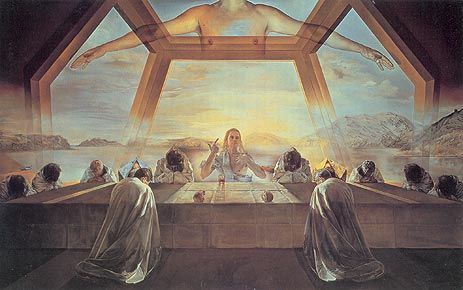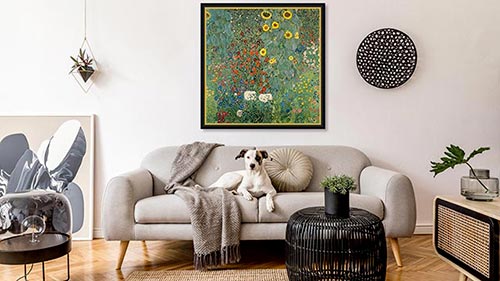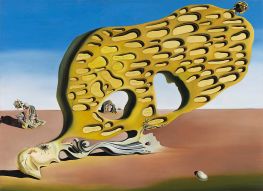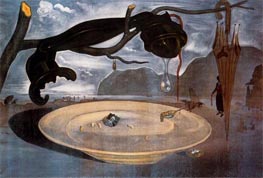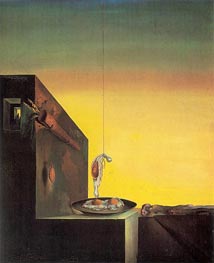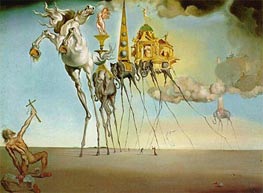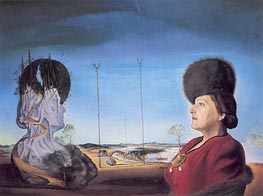The Sacrament of the Last Supper, 1955 by Salvador Dali
Canvas Print - 3421-DAS
Location: National Gallery of Art, Washington, USAOriginal Size: 167 x 268 cm
Giclée Canvas Print | $54.4 USD
Your Selection
Customize Your Print
By using the red up or down arrows, you have the option to proportionally increase or decrease the printed area in inches as per your preference.
*Max printing size: 21.8 x 35.4 in
*Max framing size: Long side up to 28"
"The Sacrament of the Last Supper" will be custom-printed for your order using the latest giclée printing technology. This technique ensures that the Canvas Print captures an exceptional level of detail, showcasing vibrant and vivid colors with remarkable clarity.
Our use of the finest quality, fine-textured canvas lends art reproductions a painting-like appearance. Combined with a satin-gloss coating, it delivers exceptional print outcomes, showcasing vivid colors, intricate details, deep blacks, and impeccable contrasts. The canvas structure is also highly compatible with canvas stretching frames, further enhancing its versatility.
To ensure proper stretching of the artwork on the stretcher-bar, we add additional blank borders around the printed area on all sides.
Our printing process utilizes cutting-edge technology and employs the Giclée printmaking method, ensuring exceptional quality. The colors undergo independent verification, guaranteeing a lifespan of over 100 years.
Please note that there are postal restrictions limiting the size of framed prints to a maximum of 28 inches along the longest side of the painting. If you desire a larger art print, we recommend utilizing the services of your local framing studio.
*It is important to mention that the framing option is unavailable for certain paintings, such as those with oval or round shapes.
If you select a frameless art print of "The Sacrament of the Last Supper" by Dali, it will be prepared for shipment within 48 hours. However, if you prefer a framed artwork, the printing and framing process will typically require approximately 7-8 days before it is ready to be shipped.
We provide complimentary delivery for up to two unframed (rolled-up) art prints in a single order. Our standard delivery is free and typically takes 10-14 working days to arrive.
For faster shipping, we also offer express DHL shipping, which usually takes 2-4 working days. The cost of express shipping is determined by the weight and volume of the shipment, as well as the delivery destination.
Once you have added the paintings to your shopping cart, you can use the "Shipping estimates" tool to obtain information about available transport services and their respective prices.
All unframed art prints are delivered rolled up in secure postal tubes, ensuring their protection during transportation. Framed art prints, on the other hand, are shipped in cardboard packaging with additional corner protectors for added safety.
Painting Information
The painting presents a carefully balanced tableau, set against a serene bay that reflects the landscape of Dalí’s beloved Catalonia. Christ is seated centrally, surrounded by twelve kneeling figures, their heads bowed in a posture of introspection. A second figure, nearly transparent, appears above - arms extended in a gesture that suggests both protection and revelation. The scene is housed within the structure of a dodecahedron, its geometric lines subtly framing the composition and articulating a space that seems both earthly and ethereal. The bread and wine, delicately placed before Christ, act as tangible reminders of the sacrament, while the figures at the table seem less concrete, reinforcing the idea of a symbolic gathering.
The color palette consists largely of soft blues, warm ochers, and pale golds, a choice that gently leads the viewer’s eye from the foreground to the luminous sky beyond. Dalí’s careful rendering of the background - featuring the cliffs and bays of Port Lligat - introduces a sense of realism that contrasts with the more otherworldly presence of the figures. The sweeping sky and glowing horizon are treated with thin, glazes of paint, giving them a radiance that envelops the setting in a mild, contemplative aura.
Dalí’s technique here favors a measured, almost classical handling of oil paint. The brushwork appears controlled and precise, recalling the disciplined methods of seventeenth-century Spanish masters, notably Francisco de Zurbarán. There is a crisp delineation of light and shadow on the figures’ cloaks, and their hair is painted with a careful attention to detail reminiscent of the old masters. This controlled approach contrasts sharply with the overtly dreamlike, disjointed presentations found in Dalí’s earlier surrealist works.
In terms of composition, the painting is striking for its reliance on symmetrical placement and proportion. The men around the table form mirrored pairs, while the dodecahedron frames Christ and the upper figure with crystalline precision. Dalí’s interest in Renaissance geometry underpins the structure: precise ratios, echoes of Pythagoras, and the ordering principles of classical art lend a cool, contemplative quality. Foreground and background are distinctly partitioned, a nod to Renaissance conventions of perspective, yet the interplay of space is anything but static. The transparent torso above Christ, devoid of the usual marks of the Passion, suggests a new interpretation of the divine, perhaps fusing creation with resurrection.
Historically, this painting marks a departure from Dalí’s reputation as a surrealist provocateur. The mid-twentieth century context - scarred by war and shifting ideologies - combined with Dalí’s reawakened religious convictions and admiration for classical precedents, shaped this more reverential approach. The carefully rendered figures, subdued palette, and conscious allusions to mathematical harmony underscore a period in Dalí’s career that values reflection over shock value. Dalí’s relationship with collectors, notably Chester Dale, further underscores the significance of this work’s public reception. Displayed at the National Gallery just before Easter in 1956, it drew crowds eager to witness Dalí’s exploration of faith and geometry. Through its balanced composition and subtle use of religious iconography, this painting stands as a thoughtful testament to Dalí’s shift toward a refined, traditional mode of expression, while retaining the touch of the extraordinary that remains vital to his oeuvre.
